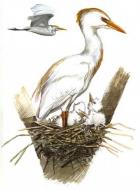Cattle Egret - Bubulcus ibis
More "compact" than the similar Egret, the Cattle Egret can be distinguished from the latter on account of its stouter body, yellow-orange bill and, during the breeding season, the golden-tawny colour of the head, breast and back feathers.
The Cattle Egret has a very wide distribution area that covers America, Africa, much of southern Asia and southern Europe: however, it has only recently colonized this last areal.
Less tied to the wetlands than the other herons, the Cattle Egret usually frequents wide open spaces, fields and grazing meadows in search of insects, reptiles and other small animals; as it searches for food it often seeks the company of large mammals, such as buffalo or horses, which as they graze frighten and put to flight the small prey on which the heron feeds. The name “Cattle Egret” comes from this habit.
Modern farming methods and rural activities have in general also changed the behavior of this species: today it is not at all unusual to see whole groups of these herons following large agricultural machinery or tractors, which carry out the same function of the big herbivores.
The Cattle Egret nests in the Fucecchio Marshes (with about 70 pairs) and at Lake Sibolla. Like many of its
kin, it builds its nest on trees often near other species.
The Cattle Egret in Italy is mostly sedentary, at the most shifting erratically in the winter months.




